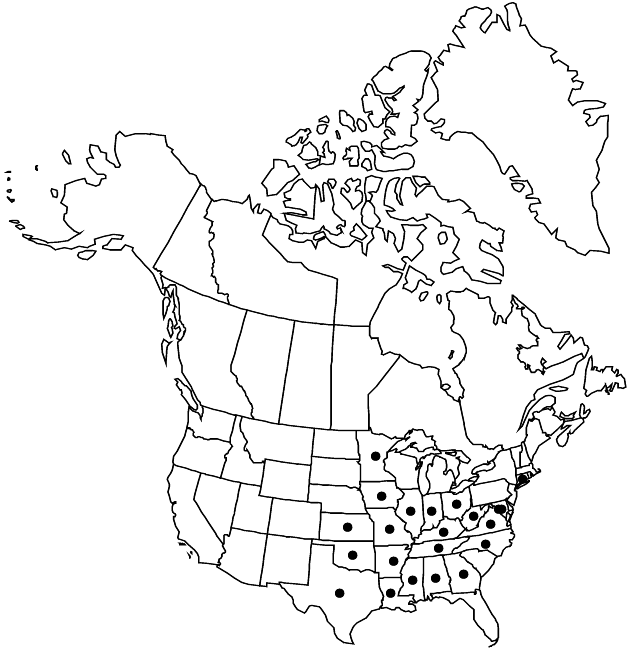Difference between revisions of "Ambrosia bidentata"
Fl. Bor.-Amer. 2: 182. 1803.
FNA>Volume Importer |
imported>Volume Importer |
||
| (6 intermediate revisions by 2 users not shown) | |||
| Line 6: | Line 6: | ||
|place=2: 182. 1803 | |place=2: 182. 1803 | ||
|year=1803 | |year=1803 | ||
| + | }} | ||
| + | |special_status={{Treatment/ID/Special_status | ||
| + | |code=E | ||
| + | |label=Endemic | ||
}} | }} | ||
|basionyms= | |basionyms= | ||
| Line 23: | Line 27: | ||
|elevation=200–500 m | |elevation=200–500 m | ||
|distribution=Ala.;Ark.;Conn.;D.C.;Ga.;Ill.;Ind.;Iowa;Kans.;Ky.;La.;Md.;Minn.;Miss.;Mo.;N.C.;Ohio;Okla.;Tenn.;Tex.;Va.;W.Va. | |distribution=Ala.;Ark.;Conn.;D.C.;Ga.;Ill.;Ind.;Iowa;Kans.;Ky.;La.;Md.;Minn.;Miss.;Mo.;N.C.;Ohio;Okla.;Tenn.;Tex.;Va.;W.Va. | ||
| − | |discussion=<p>Hybrids between Ambrosia bidentata and A. trifida have been recorded.</p> | + | |discussion=<p>Hybrids between <i>Ambrosia bidentata</i> and <i>A. trifida</i> have been recorded.</p> |
|tables= | |tables= | ||
|references= | |references= | ||
| Line 32: | Line 36: | ||
-->{{#Taxon: | -->{{#Taxon: | ||
name=Ambrosia bidentata | name=Ambrosia bidentata | ||
| − | |||
|authority=Michaux | |authority=Michaux | ||
|rank=species | |rank=species | ||
| Line 46: | Line 49: | ||
|publication title=Fl. Bor.-Amer. | |publication title=Fl. Bor.-Amer. | ||
|publication year=1803 | |publication year=1803 | ||
| − | |special status= | + | |special status=Endemic |
| − | |source xml=https:// | + | |source xml=https://bitbucket.org/aafc-mbb/fna-data-curation/src/2e0870ddd59836b60bcf96646a41e87ea5a5943a/coarse_grained_fna_xml/V19-20-21/V21_14.xml |
|tribe=Asteraceae tribe Heliantheae | |tribe=Asteraceae tribe Heliantheae | ||
|subtribe=Asteraceae (tribe Heliantheae) subtribe Ambrosiinae | |subtribe=Asteraceae (tribe Heliantheae) subtribe Ambrosiinae | ||
Latest revision as of 20:10, 5 November 2020
Annuals, 10–30(–100+) cm. Stems erect. Leaves mostly opposite; petioles 0–0.5 mm; blades ± lanceolate to lance-linear, 15–40+ × 3–6(–10+) mm, bases rounded to cordate, margins entire or with (1–)2(–4) basal lobes, abaxial and adaxial faces ± piloso-hispid and gland-dotted. Pistillate heads clustered, proximal to staminates; florets 1. Staminate heads: peduncles 0–0.5 mm; involucres obliquely cup-shaped (lateral lobe longer than others), 2.5–4 mm diam., piloso-hispid; florets 6–8+. Burs: bodies pyramidal, 5–8 mm, piloso-hispid, spines 4(–5), ± distal, ± acerose, 0.5–1 mm, tips straight.
Phenology: Flowering Jul–Oct.
Habitat: Dry, disturbed sites
Elevation: 200–500 m
Distribution

Ala., Ark., Conn., D.C., Ga., Ill., Ind., Iowa, Kans., Ky., La., Md., Minn., Miss., Mo., N.C., Ohio, Okla., Tenn., Tex., Va., W.Va.
Discussion
Hybrids between Ambrosia bidentata and A. trifida have been recorded.
Selected References
None.